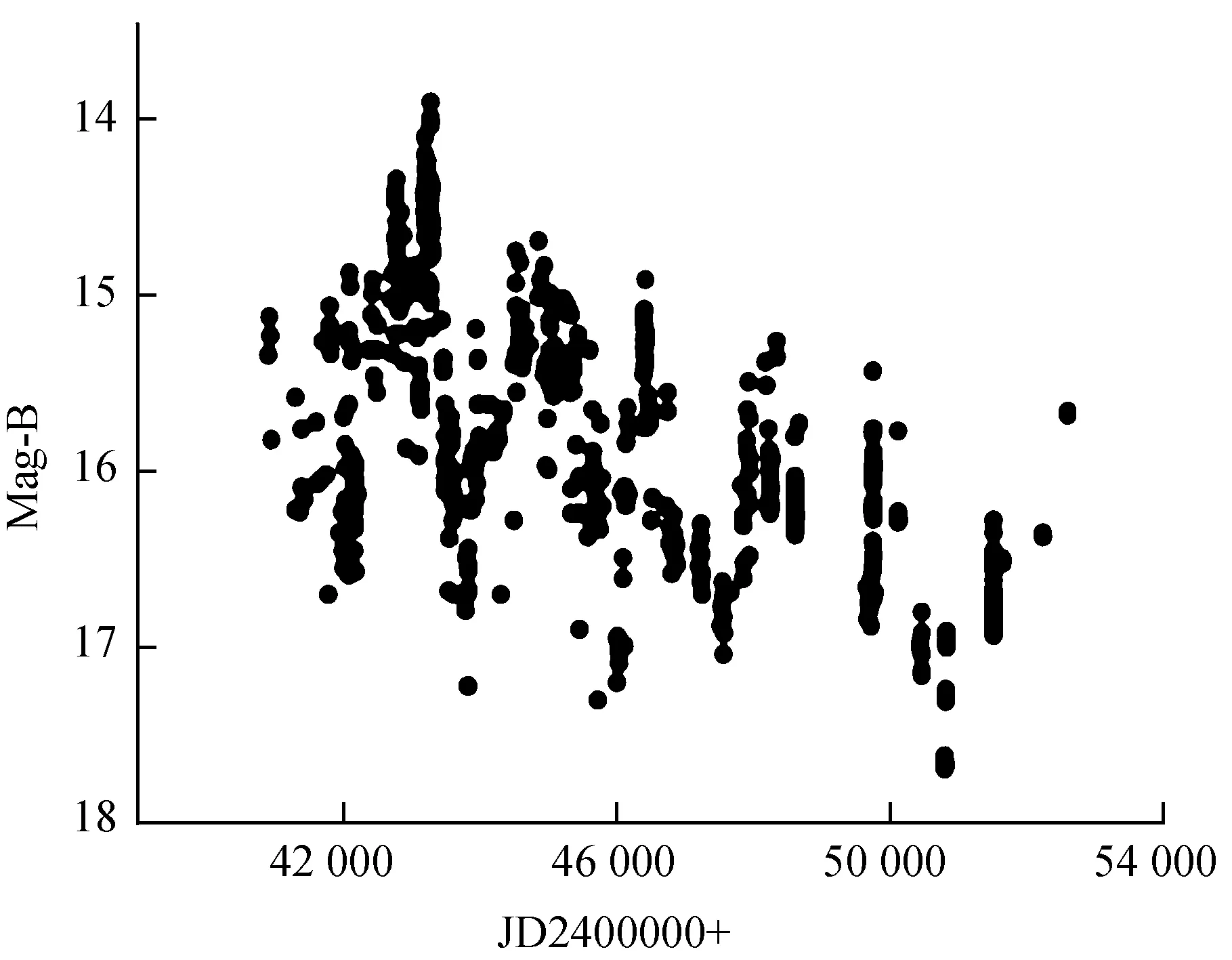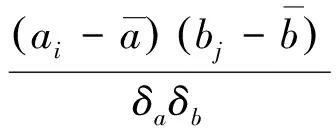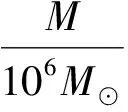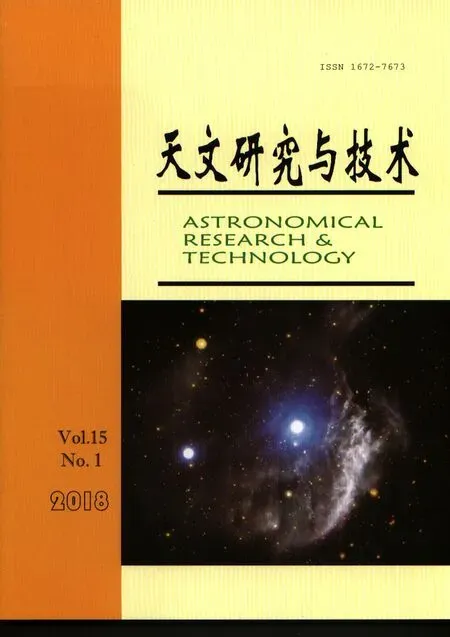蝎虎天体PKS 0735+178的光变特性分析*
余 莲,张 雄,王文广,罗双玲
(云南师范大学物理与电子信息学院,云南 昆明 650500)
BL Lac天体是活动星系核中一个重要的子类,它在观测上表现出高光度、高偏振、快速光变以及非热辐射等特征[1-2],BL Lac天体具有长周期光变和短时标光变[3-5],通过观测和研究BL Lac天体不同的光变时标能获得天体的中心黑洞质量 、 辐射区域及内部结构参数等[6-7]。因此,研究天体的光变周期非常重要。
PKS 0735+178是一颗红移为0.424的耀变体[8],它具有平射电谱和射电爆、剧烈的光变、高偏振及超光速运动等性质[9],不发出或仅发出微弱和间断的发射线[10]。众所周知,分析PKS 0735+178光变周期的方法很多,但是有些方法误差极大,对观测数据的连续性有极高的要求,并不适合周期性研究,而BL Lac型天体由于观测特征表明无发射线[1],要通过光谱观测获取光谱线,并用其研究中心黑洞质量等内部结构参数是不可能的[2-3]。本文主要使用时间补偿离散傅里叶变换、离散相关分析法和Jurkevich 3种方法对B波段和V波段的光变周期进行研究,并对比分析这3种方法,其中时间补偿离散傅里叶变换和离散相关分析法是初次用于研究 PKS 0735+178的光变周期,这两种方法对观测数据的连续性要求低,结果准确,而Jurkevich方法在文[9]中用过,并且它要求观测数据的时间序列长、连续性强。
1 样本和光变曲线
本文的数据从文[11-18]获取,收集从1970年到2002年间PKS 0735+178光学B波段和V波段的观测数据。图1和图2分别为B波段和V波段的光变曲线。从光变曲线可以看出:PKS 0735+178在光学波段活动非常激烈,在近30年的观测中,B、V波段的最大变化近3.5个星等,由于受观测条件的限制,光变曲线数据不连续,V波段将近9年没有数据,使周期性分析受到限制。
2 周期分析
2.1 时间补偿离散傅里叶变换分析PKS 0735+178的光变周期
时间补偿离散傅里叶变换方法是计算光变周期最常用的方法之一,文[19]用该方法分析PKS 1510-089红外光变周期,通过对1、sinωt、cosωt作Gram-Schmidt 正交化,得到3个正交向量,将数据投影到3个正交向量上就得到了频谱:

图1 PKS 0735+178在B波段的光变曲线
Fig.1 The light curve of quasar PKS 0735+178 in B band

图2 PKS 0735+178在V波段的光变曲线
Fig.2 The light curve of quasar PKS 0735+178 in V band
H0=1, (1)H1=cosωt, (2)H2=sinωt. (3)
正交化后:
h0=a0H0,
(4)
h1=a1H1-a1a0h0,H1,
(5)
h2=a2H2-a2a0h0,H2-a2a1h1,H2.
(6)
对于均匀采样的数据,这个过程对应于用三维 “正弦 + 常数” 模型进行曲线拟合。如果周期大于采样时间,且时间序列足够长,覆盖所有的相位,则有
(7)
功率谱强度为

(8)
其中,F(ω)为离散傅里叶变换的功率谱。在不均匀采样的情况下,F(ω)是加权的时间补偿离散傅里叶变换:

(9)
在许多蝎虎天体的观测中,观测数据f(ti)的精度各不相同。考虑到这个问题,引进权重方程ωi=ω(ti)重新定义内积:
(g1,g2)=∑ωig1(ti)g2(ti).
(10)
频率ω处的强度由下式给出:
(11)
由线性回归理论可知,0≤I(ω)≤Q,其中Q=(f,f)=∑ωif(ti)2。利用这一性质,引进标准化因子:统计量S(ω)=I(ω)/Q,称这一量为谱相关系数,对于所有频率ω,0≤S(ω)≤1。
应用上述方法获得PKS 0735+178的B波段和V波段周期图,由图3、图4可知,B波段存在0.62年、1.01年、1.67年、4.72年的光变周期,V波段存在0.58年、1.07年、1.67年、4.72年的光变周期,按文[19]中的判据,B波段存在1.01年和V波段存在1.07年光变周期的可靠性最大,而B波段和V波段存在4.72年次之。但考虑到平均时标为(1.11 ± 0.01)年的周期很可能是由于地球绕太阳所致,则光变周期B波段为4.72年,V波段为4.72年。
2.2 Jurkevich分析周期


如果样本数据划分为m组,对应第l组的统计参数为



图3 时间补偿离散傅里叶变换法分析PKS 0735+178的B波段周期
Fig.3 DCDFT method analysis of the variability period of PKS 0735+178 in B band

图4 时间补偿离散傅里叶变换法分析 PKS 0735+178的V波段周期
Fig.4 DCDFT method analysis of the variability period of PKS 0735+178 in V band
应用Jurkevich方法获得PKS 0735+178的B波段和V波段P-Vm图,由图5、图6可以看出,对应于Vm的最小值,B波段存在1.02年、1.20年、1.66年、4.77年的光变周期,V波段存在0.94年、1.71年、2.82年、3.97年的光变周期。根据光变周期存在的判据[20],B波段存在1.02年和V波段存在0.94年光变周期的可靠性最大,而B波段存在4.77和V波段存在3.97年次之.但考虑到平均时标为(1.11 ± 0.01)年,可能是由于地球绕太阳所致,因此B波段存在4.77年的周期,V波段存在3.97年的周期。

图5 Jurkevich方法分析PKS 0735+178 B波段光变周期
Fig.5 Jurkevich method analysis of the variability period of PKS 0735+178 in B band

图6 Jurkevich方法分析PKS 0735+178 V波段光变周期
Fig.6 Jurkevich method analysis of the variability period of PKS 0735+178 in V band
2.3 离散相关分析法分析
离散相关分析法是用来分析两组离散数据相关性的方法之一[21-23],文[24]用此方法分析BL Lac天体PKS 0537-441的光变特性,该方法最大的特点是不需要对数据做任何处理,就能判断出两组数据的相关性。该方法的具体步骤如下:
首先计算两组数据的离散相关函数值。如数组ai和bi,则离散相关函数值为

(19)

其次计算DCF(τ)值。通过时间延迟Δtij=ti-tj把两组数联系起来,假如时间延迟为τ,在区间τ± Δτ/2中有M个Δtij,则DCF(τ)值为

(20)
再次离散相关函数的误差为
(21)
对于所得到的离散相关图,如果峰值在0的右面,表明数组ai早于数组bi的变化。反之,数组ai就会迟于数组bi。
通过使用离散相关函数对PKS 0735+178的B波段图像进行分析,得到结果如图7、图8,从图中得到B波段存在1.21年、 2.27年、3.62年、3.81年的光变周期,V波段存在1.21年、2.22年、3.15年、4.00年的光变周期。根据离散相关示数分析周期的方法[21-23],B波段和V波段存在1.21年光变周期信息的可靠性最大,而B波段存在4.77和V波段存在3.97年次之。但考虑到平均时标为(1.11 ± 0.01)年,可能是由于地球绕太阳所致,因此PKS 0735+178 B波段的周期为3.81年,V波段的周期为4.00年。

图7 PKS 0735+178在B波段的相关性分析
Fig.7 The correlation analysis of PKS 0735+178 in B band

图8 PKS 0735+178在V波段的相关性分析
Fig.8 The correlation analysis of PKS 0735+178 in V band
3 讨论与结论

(22)
其中,α为粘滞系数;M6以106倍太阳质量为单位;M为PKS 0735+178的中心黑洞质量。
由于目前吸积盘粘滞度的起源和特性都还不清楚,用磁流体力学对其讨论是一种常用的方法,文[26]提出如果磁场的逃逸率比较低,可以认为μ=0.5,使用这个参数值,长周期爆发时间大约为2tburst,即
(23)
对于PKS 0735+178,如果α=0.1,μ=0.5,分析获得的周期是(4.33 ± 0.41) yr,可以得出其中心黑洞质量为M=0.22 × 106M⊙,这个中心黑洞质量对于PKS 0735+178来说太小,由于利用薄吸积盘理论分析方法考虑黑洞的自旋,所以中心黑洞质量偏小。但蝎虎天体的观测特性表明,这类天体在光谱观测中无发射线[10],因此研究该类天体的黑洞质量下限也是有意义的。在今后的CCD测光观测中寻找短时标光变,从而获得中心黑洞质量,与之做进一步比较。
从图3到图8可以看出,不同的方法周期性的明显程度也不一样。时间补偿离散傅里叶变换法可以运用到天体数据处理上,可以有效地处理不均匀的天文数据,克服传统的傅里叶变换带来的伪周期。时间补偿离散傅里叶变换法通过施密特正交化,有效地解决由于1、cosωt和sinωt3个向量不正交带来伪信号的问题[27]。用离散相关性函数对PKS 0735+178天体的B波段和V波段相关性分析,从图7、图8可以看出,它们之间存在很强的相关性,表明它们之间的辐射起源是相似的[24]。
另外,在光变周期信息分析中,注意到(1.11 ± 0.01)年这个结果可能和一年的观测周期有关,这个周期可能是由于有规律的观测时间间隔导致的[28],平均时标为(1.11 ± 0.01)年的周期很可能是由于地球绕太阳所致[29]。当然,也可能是天体PKS 0735+178的真实光变周期,其他光变周期信息是这个周期的N倍(N=1, 2, 3 …)[30]。这个周期的研究[30]对今后的观测有指导意义。将通过实测和更多的观测证明天体PKS 0735+178的光变周期。
[1] Dondi L, Ghisellini G. Gamma-ray-loud blazars and beaming[J]. Monthly Notices of the Royal Astronomical Society, 1995, 273(3): 583-595.
[2] 刘云, 张雄, 郑永刚, 等. Blazar天体的光变和偏振[J]. 物理学报, 2007, 56(9): 5558-5563.
Liu Yun, Zhang Xiong, Zheng Yonggang, et al. Polarization and variations of Blazar[J]. Acta Physica Sinica, 2007, 56(9): 5558-5563.
[3] Zhang X, Xie G Z, Bai J M. A historical light curve of 3C 345 and its periodic analysis[J]. Astronomy and Astrophysics, 1998, 330: 469-473.
[4] Zhang X, Zheng Y G, Zhang H J, et al. CCD photometry and optical variability of the BL Lacertae object H0323+022[J]. The Astrophysical Journal Supplement Series, 2008, 174(1): 111-116.
[5] Zhang X, Zheng Y G, Zhang L, et al. Optical CCD photometry of the variability of the BL Lacertae object ON231 in a low state[J]. Publications of the Astronomical Society of Japan, 2008, 60(2): 145-160.
[6] Xie G Z, Bai J M, Zhang X, et al. The massive black hole in the center of the active galaxy MRK 421[J]. Astronomy and Astrophysics, 1998, 334: L29-L31.
[7] Zhang X, Zhao G, Zheng Y G, et al. CCD photometry and optical variability of gamma-ray-loud BL Lacertae object OJ 287 in a low, fainter state[J]. The Astronomical Journal, 2007, 133(5): 1995-2000.
[8] Carswell R F, Strittmatter P A, Williams R E, et al. Optical observations of the radio source 0735+178[J]. The Astrophysical Journal, 1974, 190: L101-L104.
[9] 丁世学, 贺长剑. BL Lac天体PKS 0735+178 的光变周期分析[J]. 襄樊学院学报, 2003, 24(2): 3-6.
Ding Shixue, He Changjian. The periodicity analysis of the light variability of BL Lacertae object PKS 0735+178 by using Jurkevich method[J]. Journal of Xiangfan University, 2003, 24(2): 3-6.
[10]董云明. BL Lac天体的辐射机制与分类[D]. 昆明: 中国科学院国家天文台云南天文台, 2003.
[11]Webb J R, Smith A G, Leacock R J, et al. Optical observations of 22 violently variable extragalactic sources-1968-1986[J]. The Astronomical Journal, 1988, 95: 374-397.
[12]Pollock J T, Pica A J, Smith A G, et al. Long-term optical variations of 20 violently variable extragalactic radio sources[J]. The Astronomical Journal, 1979, 84: 1658-1676.
[13] Xie G Z, Li K H, Zhang Y H, et al. Simultaneous multi-range observations and detection of rapid variability of BL Lacertae objects[J]. Astronomy and Astrophysics Supplement Series, 1994, 106: 361-372.
[14]Xie G Z, Li K H, Zhang X, et al. Optical monitoring sample of the GeV gamma-ray-loud blazars[J]. The Astrophysical Journal, 1999, 522(2): 846-862.
[15]Bai J M, Xie G Z, Li K H, et al. Photometric monitoring of three BL Lacertae objects in 1993-1998[J]. Astronomy and Astrophysics Supplement Series, 1999, 136(3): 455-460.
[16]Schaefer B E. A search for rapid Variability in eight quasars and BL Lacertae objects[J]. Publications of the Astronomical Society of the Pacific, 1980, 92(547): 255-258.
[17]Qian B, Tao J. Optical monitoring of PKS 0735+178 from 1995 to 2001 and its historical periodic light curve[J]. Publications of the Astronomical Society of the Pacific, 2004, 116(816): 161-169.
[18]Zhang X, Zhang L, Zhao G, et al. Optical monitoring of three gamma-ray-loud BL Lacertae objects in 1999-2002[J]. The Astronomical Journal, 2004, 128(5): 1929-1941.
[19]罗双玲, 张雄, 王文广. 时间补偿离散傅里叶变换分析 PKS 1510-089 红外光变周期[J]. 云南师范大学学报: 自然科学版, 2016, 36(5): 1-4.
Luo Shuangling, Zhang Xiong, Wang Wenguang. The optical variability periodicity analysis of PKS 1510-089 based on date compensated discrete fourier transform[J]. Journal of Yunnan Normal University: Natural Sciences Edition, 2016, 36(5): 1-4.
[20]Jurkevich I. A method of computing periods of cyclic phenomena[J]. Astrophysics and Space Science, 1971, 13(1): 154-167.
[21]高蓉, 杨金雪, 李怀珍. BL Lac天体PKS2155-304光变特性分析[J]. 云南师范大学学报: 自然科学版, 2015, 35(1): 1-4.
Gao Rong, Yang Jinxue, Li Huaizhen. The variability analysis of BL Lac objects PKS 2155-304[J]. Journal of Yunnan Normal University: Natural Sciences Edition, 2015, 35(1): 1-4.
[22] Edelson R A, Krolik J H. The discrete correlation function-a new method for analyzing unevenly sampled variability data[J]. The Astrophysical Journal, 1988, 333: 646-659.
[23] Hufnagel B R, Bregman J N. Optical and radio variability in blazars[J]. The Astrophysical Journal, 1992, 386: 473-484.
[24] 王文广, 张皓晶, 王雪品, 等. BL Lac天体PKS 0537-441的光变特性分析[J]. 云南师范大学学报: 自然科学版, 2016, 36(4): 1-7.
Wang Wenguang, Zhang Haojing, Wang Xuepin, et al. The variability analysis of BL Lac objects PKS 0537-441[J]. Journal of Yunnan Normal University: Natural Sciences Edition, 2016, 36(4): 1-7.
[25] Smith P S, Balonek T J, Elston R, et al. Optical and near-infrared observations of BL Lacertae objects and active quasars[J]. The Astrophysical Journal Supplement Series, 1987, 64: 459-485.
[26] Horiuchi T, Kato S. A model of hydromagnetic turbulent viscosity in radiation-pressure-dominated disks[J]. Publications of the Astronomical Society of Japan, 1990, 42(5): 661-674.
[27] 李娟. Blazar光变研究[D]. 广州: 广州大学, 2007.
[28] Kidger M, Takalo L, Sillanpaa A. A new analysis of the 11-year period in OJ287-confirmation of its existence[J]. Astronomy and Astrophysics, 1992, 264: 32-36.
[29] Liu F K, Xie G Z, Bai J M. A historical light curve of ON 231 and its periodic analysis[J]. Astronomy and Astrophysics, 1995, 295: 1-10.
[30] Fan J H, Xie G Z, Lin R G, et al. The long-term variability of BL Lac object PKS 0735+178[J]. Astronomy and Astrophysics Supplement Series, 1997, 125(3): 525-528.

